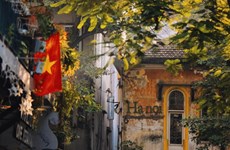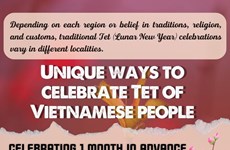Colour of spring in Tu Binh folk paintings
Many paintings depicting history and folklore are on display at “The Colour of Spring in Tu Binh Folk Paintings”, held at the Vietnam Fine Arts Museum. They will be on display until the end of February 2022.
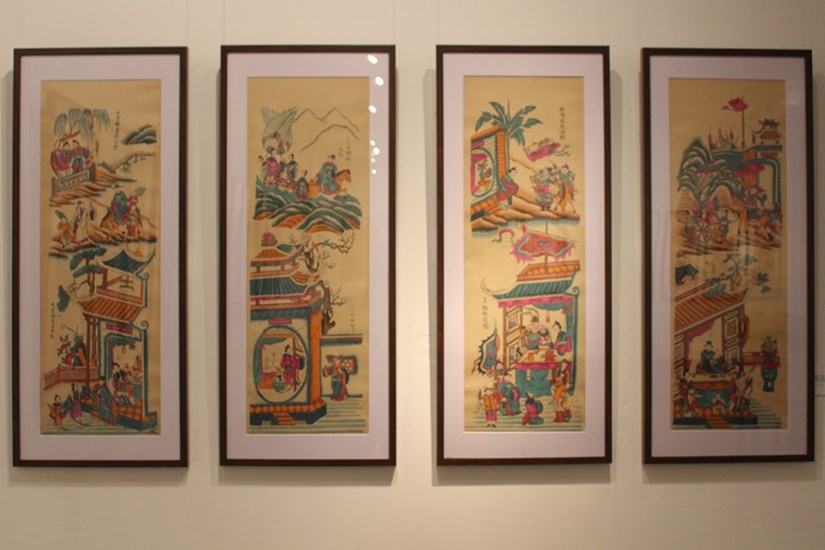 Many paintings depicting history and folklore are on display at “The Colour of Spring in Tu Binh Folk Paintings”, held at the Vietnam Fine Arts Museum. They will be on display until the end of February 2022. The display is open to the public for the upcoming traditional Vietnamese Lunar New Year, as well as to celebrate the founding anniversary of the Communist Party of Vietnam (February 3, 1930 - February 3, 2022). Hang Trong folk paintings are one of the most outstanding folk painting genres in Vietnam, though they are at risk of falling into oblivion. The collection is a precious treasure that has been preserved by the Vietnam Fine Arts Museum for decades. (Photo: VietnamPlus)
Many paintings depicting history and folklore are on display at “The Colour of Spring in Tu Binh Folk Paintings”, held at the Vietnam Fine Arts Museum. They will be on display until the end of February 2022. The display is open to the public for the upcoming traditional Vietnamese Lunar New Year, as well as to celebrate the founding anniversary of the Communist Party of Vietnam (February 3, 1930 - February 3, 2022). Hang Trong folk paintings are one of the most outstanding folk painting genres in Vietnam, though they are at risk of falling into oblivion. The collection is a precious treasure that has been preserved by the Vietnam Fine Arts Museum for decades. (Photo: VietnamPlus)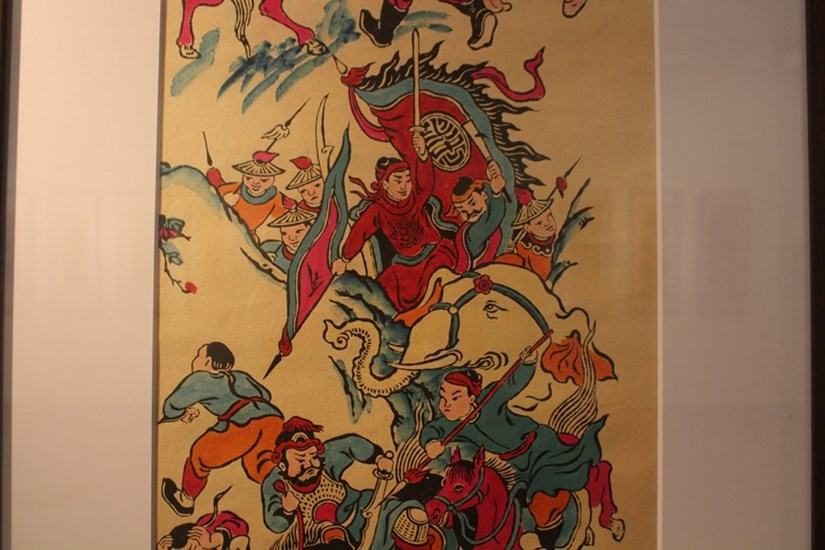 “Quang Trung Ra Bac” artwork on show. According to researcher Phan Ngoc Khue, Tu Binh paintings often depict important historical events or heroes of the nation. Hang Trong folk paintings are one of the most outstanding folk painting genres in Vietnam, however the tradition is at risk of being lost forever. There are two common types of Hang Trong paintings, one for worshipping and the other for Tet (Lunar New Year) decoration. Like other traditional art genres in the country, Hang Trong paintings are at risk of falling into oblivion. The event contributes to upholding and bringing into play values of the Hang Trong folk painting genre. (Photo: VietnamPlus)
“Quang Trung Ra Bac” artwork on show. According to researcher Phan Ngoc Khue, Tu Binh paintings often depict important historical events or heroes of the nation. Hang Trong folk paintings are one of the most outstanding folk painting genres in Vietnam, however the tradition is at risk of being lost forever. There are two common types of Hang Trong paintings, one for worshipping and the other for Tet (Lunar New Year) decoration. Like other traditional art genres in the country, Hang Trong paintings are at risk of falling into oblivion. The event contributes to upholding and bringing into play values of the Hang Trong folk painting genre. (Photo: VietnamPlus) The Tu Binh is a line of Hang Trong folk paintings, which dates back to the 16th century. It is a set of four paintings, portraying the rotation of things in the universe according to the Asian concept, such as the four seasons of the year, the four stages of life, four anecdotes in a story; the beauty of the girls playing four different musical instruments and four precious kinds of flowers, among others. Each of these paintings has vivid colours that reflect the beauty and rich culture of the community where they originated. In the folk paintings, there are Nom writings showing people’s wishes for a happier, healthier, and wealthier life. (Photo: VietnamPlus)
The Tu Binh is a line of Hang Trong folk paintings, which dates back to the 16th century. It is a set of four paintings, portraying the rotation of things in the universe according to the Asian concept, such as the four seasons of the year, the four stages of life, four anecdotes in a story; the beauty of the girls playing four different musical instruments and four precious kinds of flowers, among others. Each of these paintings has vivid colours that reflect the beauty and rich culture of the community where they originated. In the folk paintings, there are Nom writings showing people’s wishes for a happier, healthier, and wealthier life. (Photo: VietnamPlus)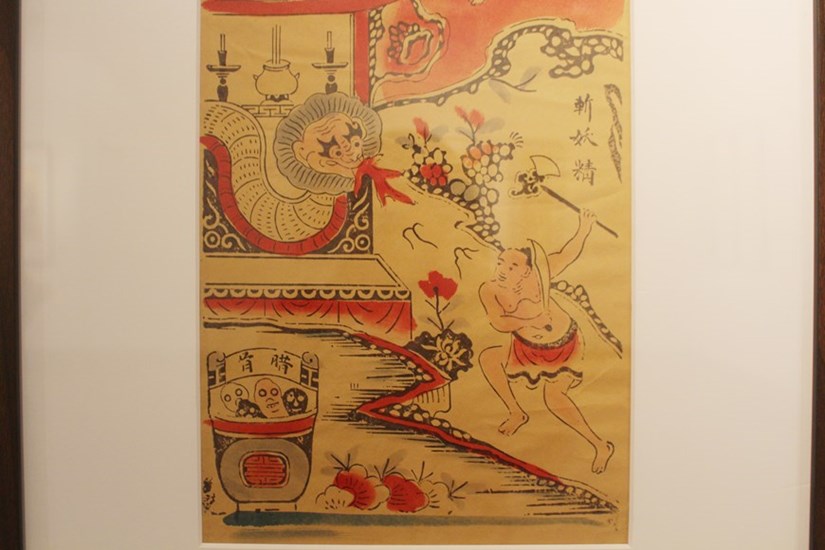 Besides historical stories, the exhibition also introduces ‘Thach Sanh” in the fairy tale the “Story of Thach Sanh”. To make a traditional Hang Trong painting, the craftsman starts with woodblocks to print black outlines, then draws details and finally colours the picture by hand. Because the main part of the process is made by hand, Hang Trong pictures are slightly different from one to another, thus they become more valuable for fastidious customers in Hanoi. The paper used in making Hang Trong paintings is called ‘Xuyen Chi’, which differs from the natural colour paper of Dong Ho painting, a renowned folk painting genre in nearby Bac Ninh province. (Photo: VietnamPlus)
Besides historical stories, the exhibition also introduces ‘Thach Sanh” in the fairy tale the “Story of Thach Sanh”. To make a traditional Hang Trong painting, the craftsman starts with woodblocks to print black outlines, then draws details and finally colours the picture by hand. Because the main part of the process is made by hand, Hang Trong pictures are slightly different from one to another, thus they become more valuable for fastidious customers in Hanoi. The paper used in making Hang Trong paintings is called ‘Xuyen Chi’, which differs from the natural colour paper of Dong Ho painting, a renowned folk painting genre in nearby Bac Ninh province. (Photo: VietnamPlus)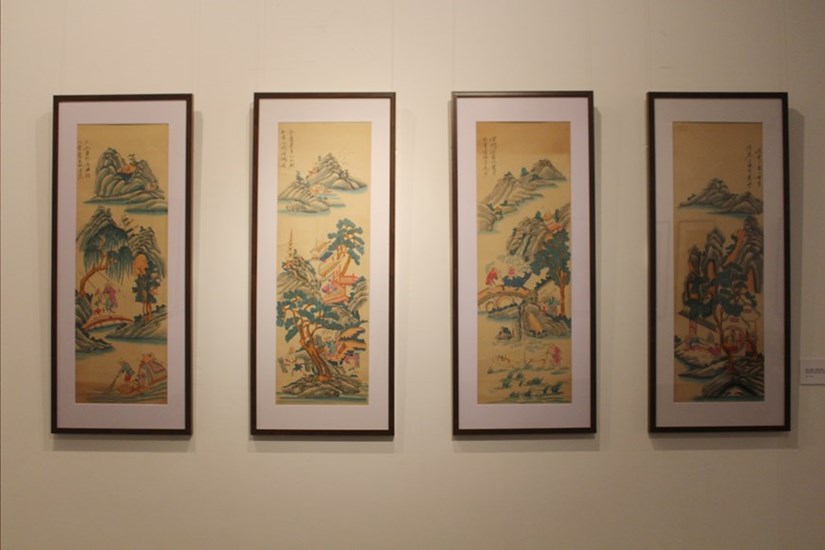 The “Kim Van Kieu” painting of the Hang Trong genre on display. The two above-mentioned groups of topics in Tu Binh paintings are classified as decorative paintings of the Hang Trong genre. Hang Trong folk painting - a combination of traditional cultural values with ancient artistic methods - has contributed to the development of the folk painting craft, making it flourish once upon a time. The craftsman uses the wood carving technique to print colourful inks on “do” paper. In making a painting, they start with woodblocks to print black outlines, then draw the details and finally colour the picture by hand. (Photo: VietnamPlus)
The “Kim Van Kieu” painting of the Hang Trong genre on display. The two above-mentioned groups of topics in Tu Binh paintings are classified as decorative paintings of the Hang Trong genre. Hang Trong folk painting - a combination of traditional cultural values with ancient artistic methods - has contributed to the development of the folk painting craft, making it flourish once upon a time. The craftsman uses the wood carving technique to print colourful inks on “do” paper. In making a painting, they start with woodblocks to print black outlines, then draw the details and finally colour the picture by hand. (Photo: VietnamPlus)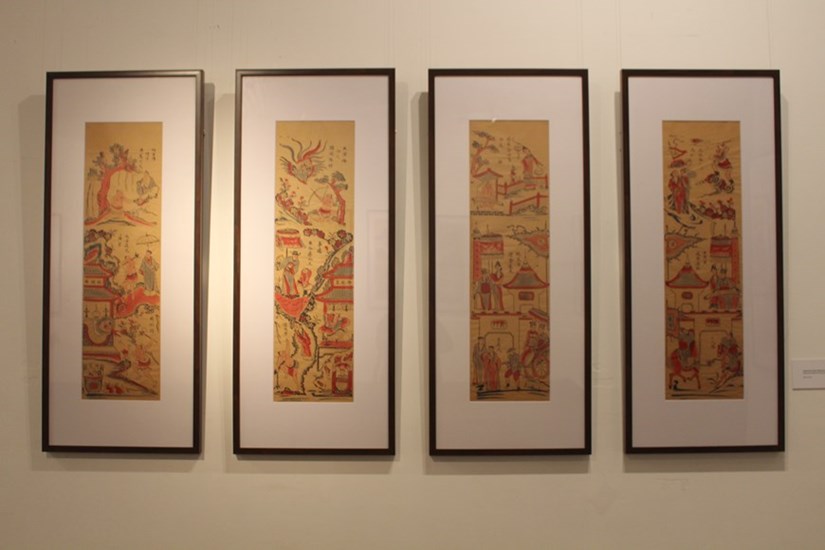 Depending on the meaning, Tu Binh paintings could be displayed on the altar, in front of the house, or in the courtyard of ancient Vietnamese houses. At certain times of the year, particularly Tet, the Lunar New Year, they are an indispensable element of the occasion. The Colour of Spring on Tu Binh Folk Painting exhibition features 20 sets of Tu Binh folk paintings themed Tu Quy (Four Seasons of the Year), and To Nu (Four Female Musicians), the Tu Dan (Four Important Careers of the Human, including Fishing, Woodcutting, Farming, Teaching), among others. The exhibition is open to the public for the upcoming traditional Vietnamese Lunar New Year, as well as to celebrate the founding anniversary of the Communist Party of Vietnam. (Photo: Vietnamplus)
Depending on the meaning, Tu Binh paintings could be displayed on the altar, in front of the house, or in the courtyard of ancient Vietnamese houses. At certain times of the year, particularly Tet, the Lunar New Year, they are an indispensable element of the occasion. The Colour of Spring on Tu Binh Folk Painting exhibition features 20 sets of Tu Binh folk paintings themed Tu Quy (Four Seasons of the Year), and To Nu (Four Female Musicians), the Tu Dan (Four Important Careers of the Human, including Fishing, Woodcutting, Farming, Teaching), among others. The exhibition is open to the public for the upcoming traditional Vietnamese Lunar New Year, as well as to celebrate the founding anniversary of the Communist Party of Vietnam. (Photo: Vietnamplus)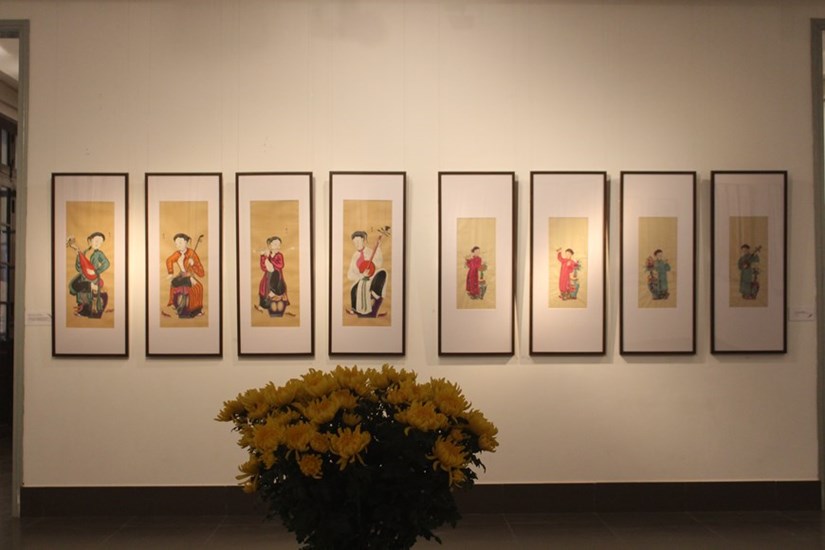 The Tu Binh painting sets with this theme show the close links with the daily life of the people in the past. In the traditional making of Hang Trong paintings, after printing black outlines and drawing details, craftsmen colour their pictures with pigments, and therefore the tone of Hang Trong paintings is usually bright and attractive with principal colours being pink, blue, green, red and yellow. The aesthetic value in pictures of Hang Trong painting is more urban than in the Dong Ho ones, which are made in the countryside and often reflect the perspective of farmers. One of the most popular folk painting genres in Vietnam, Hang Trong painting is closely associated with the culture of the capital city of Hanoi. (Photo: VietnamPlus)
The Tu Binh painting sets with this theme show the close links with the daily life of the people in the past. In the traditional making of Hang Trong paintings, after printing black outlines and drawing details, craftsmen colour their pictures with pigments, and therefore the tone of Hang Trong paintings is usually bright and attractive with principal colours being pink, blue, green, red and yellow. The aesthetic value in pictures of Hang Trong painting is more urban than in the Dong Ho ones, which are made in the countryside and often reflect the perspective of farmers. One of the most popular folk painting genres in Vietnam, Hang Trong painting is closely associated with the culture of the capital city of Hanoi. (Photo: VietnamPlus) Hang Trong folk paintings are one of the most outstanding folk painting genres in Vietnam, however the tradition is at risk of being lost forever. There are two common types of Hang Trong paintings, one for worshipping and the other for Tet (Lunar New Year) decoration. The craftsman uses the wood carving technique to print colourful inks on “do” paper. This type of painting has been rated by researchers as highly aesthetical and sophisticated thanks to its woodblock printing and colouring techniques. The paintings also feature deep imprints of the culture and era when they came into being, while vivid colours reflect the beauty of the community where they originated. (Photo: VietnamPlus)
Hang Trong folk paintings are one of the most outstanding folk painting genres in Vietnam, however the tradition is at risk of being lost forever. There are two common types of Hang Trong paintings, one for worshipping and the other for Tet (Lunar New Year) decoration. The craftsman uses the wood carving technique to print colourful inks on “do” paper. This type of painting has been rated by researchers as highly aesthetical and sophisticated thanks to its woodblock printing and colouring techniques. The paintings also feature deep imprints of the culture and era when they came into being, while vivid colours reflect the beauty of the community where they originated. (Photo: VietnamPlus)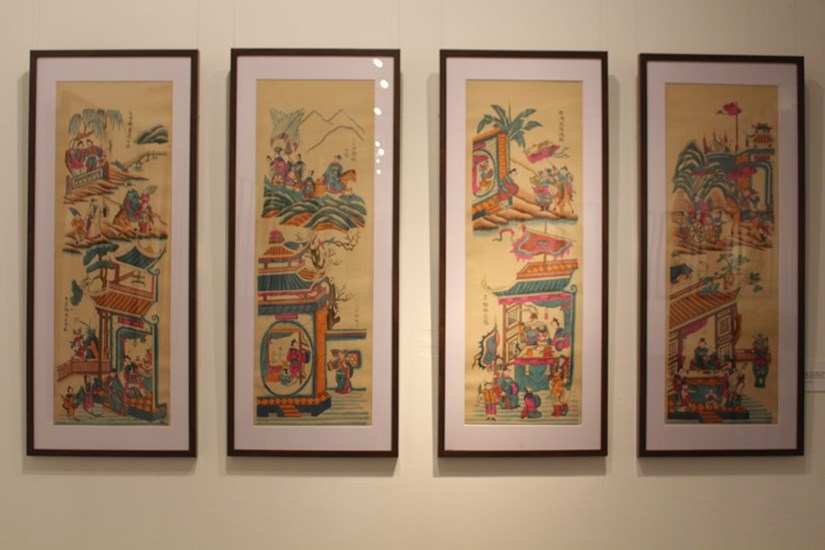 The folk painting “Ngu Canh Tieu Doc” (Tu Dan) (Four Important Careers of the Human, including Fishing, Woodcutting, Farming, Teaching) depicts the beauty of people in working and nature. Hang Trong paintings date back to about the 16th century and peaked in the late 19th and early 20th centuries. This type of painting has been rated by researchers as highly aesthetical and sophisticated thanks to its woodblock printing and colouring techniques. The paintings also feature deep imprints of the culture and era when they came into being, while vivid colours reflect the beauty of the community where they originated. The collection is a precious treasure that has been preserved by the Vietnam Fine Arts Museum for decades. (Photo: VietnamPlus)
The folk painting “Ngu Canh Tieu Doc” (Tu Dan) (Four Important Careers of the Human, including Fishing, Woodcutting, Farming, Teaching) depicts the beauty of people in working and nature. Hang Trong paintings date back to about the 16th century and peaked in the late 19th and early 20th centuries. This type of painting has been rated by researchers as highly aesthetical and sophisticated thanks to its woodblock printing and colouring techniques. The paintings also feature deep imprints of the culture and era when they came into being, while vivid colours reflect the beauty of the community where they originated. The collection is a precious treasure that has been preserved by the Vietnam Fine Arts Museum for decades. (Photo: VietnamPlus)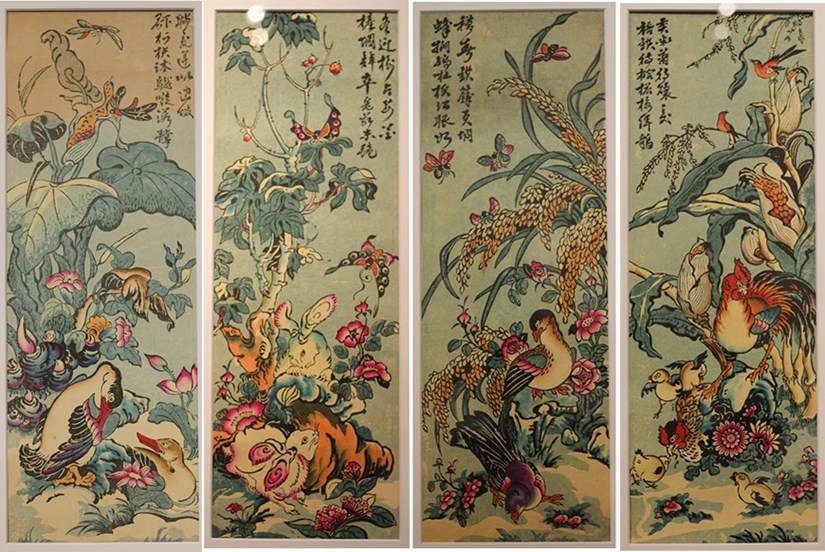 Various sets of “Bon Mua” (The Four Seasons) Tu Binh paintings are on display. Before the 1970s, Hang Trong prints were on sale all over Hanoi three weeks before Tet. The paintings were once very popular among Vietnamese and displayed for sale on the ancient streets of Hang Trong, Hang Non, or Hang Quat in Hanoi’s Old Quarter area. The paintings are deeply rooted in the soul of Hanoi and keep their unchanging features despite the upheavals of the times. Depending on the meaning, Tu Binh painting sets may be displayed on the altar, in front of the house, or the courtyard of Vietnamese ancient houses. (Photo: VietnamPlus)
Various sets of “Bon Mua” (The Four Seasons) Tu Binh paintings are on display. Before the 1970s, Hang Trong prints were on sale all over Hanoi three weeks before Tet. The paintings were once very popular among Vietnamese and displayed for sale on the ancient streets of Hang Trong, Hang Non, or Hang Quat in Hanoi’s Old Quarter area. The paintings are deeply rooted in the soul of Hanoi and keep their unchanging features despite the upheavals of the times. Depending on the meaning, Tu Binh painting sets may be displayed on the altar, in front of the house, or the courtyard of Vietnamese ancient houses. (Photo: VietnamPlus)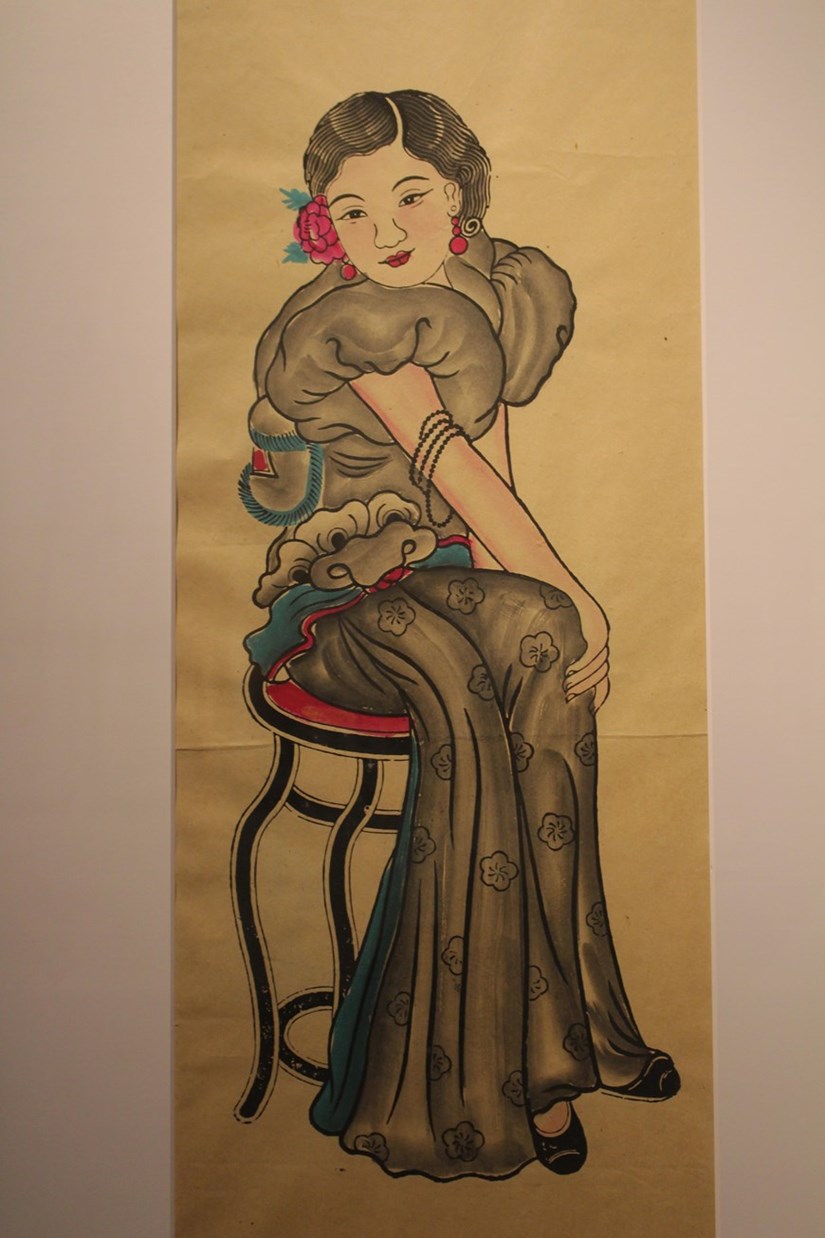 Hang Trong paintings are a genre of Vietnamese woodcut paintings that originated from the area of Hang Trong and Hang Non streets in the Old Quarter of Hanoi. The genre dates back to the 16th century and peaked in the late 19th and early 20th centuries. Some popular pictures of Hang Trong paintings are ‘Ngu ho’ (Five Tigers), ‘Ly Ngu Vong Nguyet’ (Carp Looking at the Moon), ‘Tu Binh’ (Four Female Musicians), and ‘To Nu’ (Virgin Girl). This type of painting has been rated by researchers as highly aesthetical and sophisticated thanks to its woodblock printing and colouring techniques. The paintings also feature deep imprints of the culture and era when they came into being. (Photo: VietnamPlus)
Hang Trong paintings are a genre of Vietnamese woodcut paintings that originated from the area of Hang Trong and Hang Non streets in the Old Quarter of Hanoi. The genre dates back to the 16th century and peaked in the late 19th and early 20th centuries. Some popular pictures of Hang Trong paintings are ‘Ngu ho’ (Five Tigers), ‘Ly Ngu Vong Nguyet’ (Carp Looking at the Moon), ‘Tu Binh’ (Four Female Musicians), and ‘To Nu’ (Virgin Girl). This type of painting has been rated by researchers as highly aesthetical and sophisticated thanks to its woodblock printing and colouring techniques. The paintings also feature deep imprints of the culture and era when they came into being. (Photo: VietnamPlus)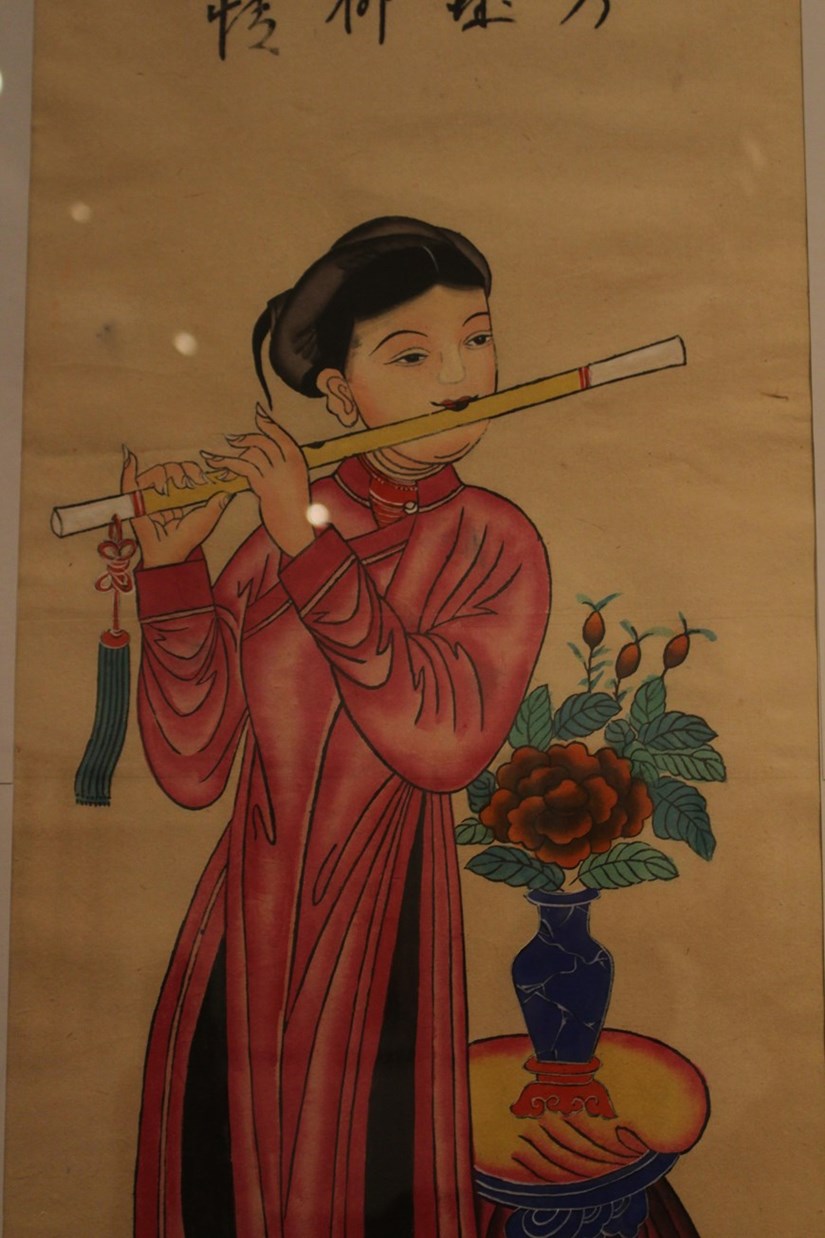 Twenty sets of Tu Binh folk paintings themed the Tu Quy (Four Seasons of the Year), To Nu (Four Female Musicians), and Tu Dan (Four Important Careers of the Human, including Fishing, Woodcutting, Farming, Teaching) on display. The exhibition introduced three sets of folk paintings of the Hang Trong genre and one set of the Dong Ho genre. The “To Nu” painting of Hang Trong genre depicts four graceful girls playing four different types of musical instruments, while the “To Nu” of the Dong Ho genre depicts four women with short hair in Western dresses. The exhibition was part of events to welcome the upcoming traditional Vietnamese Lunar New Year as well as to celebrate the founding anniversary of the Communist Party of Vietnam. (Photo: VietnamPlus)
Twenty sets of Tu Binh folk paintings themed the Tu Quy (Four Seasons of the Year), To Nu (Four Female Musicians), and Tu Dan (Four Important Careers of the Human, including Fishing, Woodcutting, Farming, Teaching) on display. The exhibition introduced three sets of folk paintings of the Hang Trong genre and one set of the Dong Ho genre. The “To Nu” painting of Hang Trong genre depicts four graceful girls playing four different types of musical instruments, while the “To Nu” of the Dong Ho genre depicts four women with short hair in Western dresses. The exhibition was part of events to welcome the upcoming traditional Vietnamese Lunar New Year as well as to celebrate the founding anniversary of the Communist Party of Vietnam. (Photo: VietnamPlus) “The Colour of Spring on Tu Binh Folk Painting” exhibition features 20 sets of Tu Binh folk paintings themed the Tu Quy (Four Seasons of the Year), To Nu (Four Female Musicians), and Tu Dan (Four Important Careers of the Human, including Fishing, Woodcutting, Farming, Teaching), among others. The exhibition was part of events to welcome the upcoming traditional Vietnamese Lunar New Year as well as to celebrate the founding anniversary of the Communist Party of Vietnam (February 3, 1930 - February 3, 2022). The collection is a precious treasure that has been preserved by the Vietnam Fine Arts Museum for decades. (Photo: VietnamPlus)
“The Colour of Spring on Tu Binh Folk Painting” exhibition features 20 sets of Tu Binh folk paintings themed the Tu Quy (Four Seasons of the Year), To Nu (Four Female Musicians), and Tu Dan (Four Important Careers of the Human, including Fishing, Woodcutting, Farming, Teaching), among others. The exhibition was part of events to welcome the upcoming traditional Vietnamese Lunar New Year as well as to celebrate the founding anniversary of the Communist Party of Vietnam (February 3, 1930 - February 3, 2022). The collection is a precious treasure that has been preserved by the Vietnam Fine Arts Museum for decades. (Photo: VietnamPlus)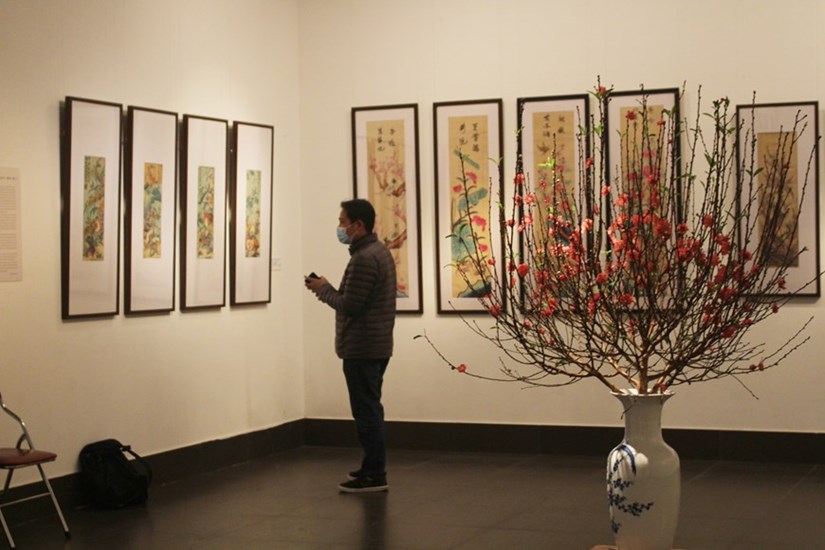 To make a traditional Hang Trong painting, the craftsman starts with woodblocks to print black outlines, then draws details and finally colours the picture by hand. Because the main part of the process is made by hand, all Hang Trong paintings are slightly different from one to another, thus they become more valuable for the fastidious customers in Hanoi. However, the craft is now at risk of falling into oblivion. The exhibition, which will last until late February, aims to raise public awareness of the importance to preserve the legacy of Hanoians in particular and Vietnamese in general. It was part of events to welcome the upcoming traditional Vietnamese Lunar New Year as well as to celebrate the founding anniversary of the Communist Party of Vietnam. (Photo: VietnamPlus)./.
To make a traditional Hang Trong painting, the craftsman starts with woodblocks to print black outlines, then draws details and finally colours the picture by hand. Because the main part of the process is made by hand, all Hang Trong paintings are slightly different from one to another, thus they become more valuable for the fastidious customers in Hanoi. However, the craft is now at risk of falling into oblivion. The exhibition, which will last until late February, aims to raise public awareness of the importance to preserve the legacy of Hanoians in particular and Vietnamese in general. It was part of events to welcome the upcoming traditional Vietnamese Lunar New Year as well as to celebrate the founding anniversary of the Communist Party of Vietnam. (Photo: VietnamPlus)./.








